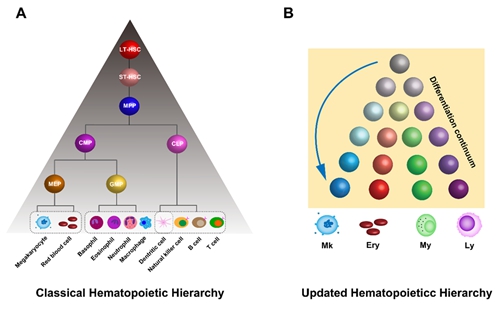Hematopoiesis, a dynamic and well-organized process, is maintained by a rare number of multipotent cells – hematopoietic stem cells (HSCs). HSCs not only can self-renew to sustain the stability of HSC pool, but also can differentiate into different types of mature blood cells.
To illustrate the whole differentiation process of HSCs, the classical hematopoietic hierarchy roadmap was proposed in 2000. Since then, the classical hematopoietic hierarchy roadmap has become a dogma to define the lineage relationship between HSCs and their descendants. Recently, with the improvement of precision and throughput of HSC study, extensive evidence demonstrates that the classical roadmap needs to be updated to describe new features of HSC differentiation.
A Review entitled “Hematopoietic hierarchy – an updated roadmap” was written by Liu group and was published online in Trends in Cell Biology (June 20, 2018).
In this Review, Liu and his colleagues briefly introduce the classical hematopoietic hierarchy roadmap. Then, they mainly focus on recent advances in hematopoietic hierarchy: (a) Hematopoiesis is a continuous process, which means those previously pre-defined intermediate progenitors are transitory states of continuous process. (b) Megakaryocyte (platelet) segregation occurs early, suggesting megakaryocytes (platelets) can be differentiated directly from HSCs. (c) HSCs is a heterogeneous population, which is reflected in molecular signature, cell fate and functional output. Moreover, they also pinpoint that hematopoiesis undergoes distinct differentiation paths under different physiological conditions, which indicates that invasive or native experimental methods will generate different hematopoietic outcomes. Finally, they also propose future directions/applications with the updated hierarchy roadmap.
This study was supported by grants from the National Natural Science Foundation of China (81530004 and 31425016), and the Ministry of Science and Technology of China (2016YFA0100500) and the Strategic Priority Research Program of the Chinese Academy of Sciences (XDA16010104).

Hematopoietic hierarchy. (A) Classical hematopoietic hierarchy. HSCs undergo a stepwise differentiation process to generate different types of mature blood cells. (B)Updated hematopoietic hierarchy. HSCs produce mature blood cells passing through series of transitory states (also known as differentiation continuum). Moreover, megakaryocytes (platelets) can be differentiated directly from HSCs (blue arrow).

